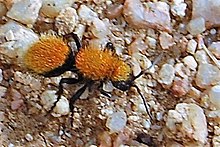Mutillidae
| Mutillidae | |
|---|---|
 |
|
| Dasymutilla sp. | |
| Scientific classification | |
| Kingdom: | Animalia |
| Phylum: | Arthropoda |
| Class: | Insecta |
| Order: | Hymenoptera |
| Suborder: | Apocrita |
| Superfamily: | Vespoidea |
| Family: | Mutillidae |
| Subfamilies | |
|
Mutillinae |
|
Mutillinae
Myrmillinae
Pseudophotopsidinae
Rhopalomutillinae
Sphaeropthalminae
Ticoplinae
The Mutillidae are a family of more than 3,000 species of wasps (despite the names) whose wingless females resemble large, hairy ants. Their common name velvet ant refers to their dense pile of hair, which most often is bright scarlet or orange, but may also be black, white, silver, or gold. Black and white specimens are sometimes known as panda ants due to their hair coloration resembling that of the giant panda. Their bright colors serve as aposematic signals. They are known for their extremely painful stings, hence the common name cow killer or cow ant. Unlike real ants, they do not have drones, workers, and queens. However, velvet ants do exhibit haplodiploid sex determination similar to other members of the Hymenoptera, including the Vespoidea.
The exoskeleton of all velvet ants is unusually tough (to the point that some entomologists have reported difficulty piercing them with steel pins when attempting to mount them for display in cabinets). This characteristic allows them to successfully invade the nests of their prey and also helps them retain moisture. Like related families in the Vespoidea, males have wings, but females are wingless. They exhibit extreme sexual dimorphism. The males and females are distinct enough in their morphology, that it is often very hard to decide whether or not a given male and female belong to the same species, unless they are captured while mating. In a few species, the male carries the smaller female aloft while mating, which is also seen in the related family Thynnidae.
In mutillids, as in all Aculeata, only the female is capable of inflicting a sting because the stinger itself is a modified female organ called an ovipositor; female mutillids have unusually long and maneuverable stingers. In both sexes, a structure called a stridulitrum on the metasoma is used to produce a squeaking or chirping sound when alarmed. Both sexes of mutillids also bear hair-lined grooves on the side of the metasoma called felt lines. Only two other vespoid families, (Bradynobaenidae and Chyphotidae) have felt lines, but the females of these families have a distinct pronotum. Members of the family Myrmosidae, formerly classified as a subfamily of mutillids, also have a distinct pronotum in females, but lack felt lines in both sexes.
...
Wikipedia
